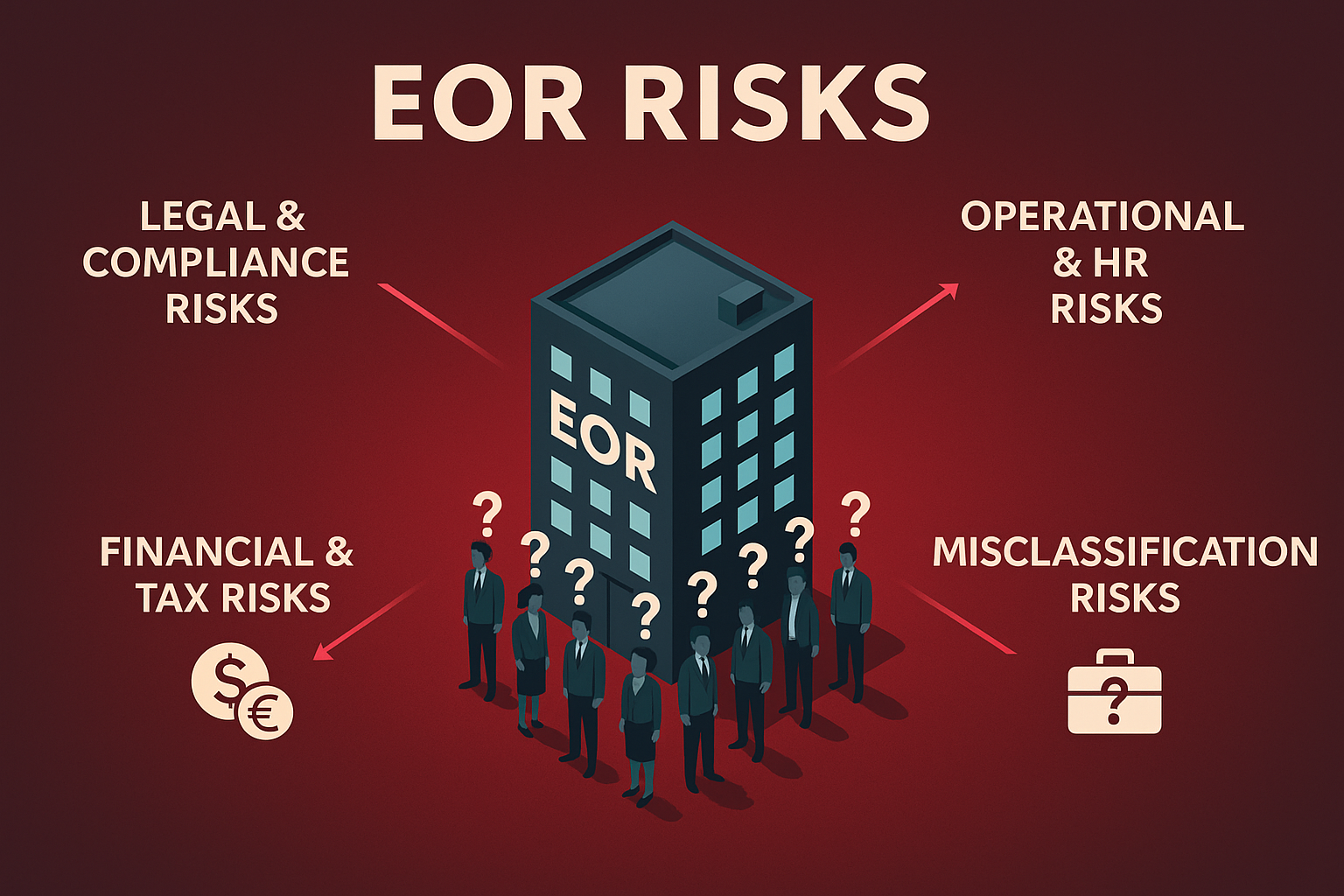Global expansion becomes risky when businesses rely on an EOR without fully understanding the hidden compliance, tax, and operational pitfalls behind the model.
By recognizing these risks early and structuring the right safeguards, companies can scale confidently without exposing themselves to costly surprises.

The Employer of Record market might hit $9.8 billion by 2028. But that growth hides something decision-makers rarely discuss until it's too late: regulatory crackdowns, operational failures, and a widening gap between what EOR contracts promise and what they deliver when things break.
Understanding where liability actually sits isn't optional anymore. It's survival-level risk management. This guide shows you how to audit your provider before a payroll failure, misclassification dispute, or regulatory shift exposes gaps you didn't know existed.
Why EOR Regulations Are Tightening and What It Means for Your Business?
EORs were originally designed for short-term market testing, but as companies now use them for permanent, long-term hiring, the risk profile changes because a temporary workaround becomes an ongoing employment relationship where both the EOR and your company share control and liability.
Countries are tightening EOR rules, Singapore is limiting foreign hires, the UK is cracking down on umbrella firms, and the EU is scrutinizing co-employment.
Stricter oversight means businesses face greater risk if their EOR isn’t fully compliant.
Six Categories of EOR Risk That Decision-Makers Overlook
1. Structural Risk: Aggregators vs. Direct Entity Models
Many EORs don’t run their own entities; they rely on layers of third-party partners. That means the company legally employing your team may be several steps removed from the brand you signed with.
This creates real risks: inconsistent service, currency issues, and uneven employee support. A team in Germany might get fast help while your Brazil team waits days, and you usually won’t spot these gaps until after onboarding.
2. Compliance Failures and Misclassification Exposure
Misclassification triggers back taxes, penalties, and unpaid benefits liability. California alone imposes penalties exceeding $25,000 per violation.
Weak EORs lack in-country legal expertise. They apply templated contracts across markets with vastly different standards. They miss regional nuances like Colombia's integral salary rules or France's working time regulations.
Violations of labor laws lead to penalties and social security liability. Co-employment doctrine means you share exposure when errors surface during audits.
3. Permanent Establishment: The Co-Employment Trap
If your managers direct work, sign contracts, or make hiring decisions within a foreign country, you may create a taxable presence regardless of EOR involvement.
Example: A U.S. company uses an EOR for a sales team in Germany. The VP of Sales conducts reviews, approves payouts, and negotiates contracts on German soil during visits. Tax authorities could argue that operational control exists in Germany, creating PE exposure and subjecting the company to German corporate tax.
4. Payroll, Tax, and Financial Infrastructure Failures
Payroll failures quickly damage trust, as Late salaries, wrong tax deductions, or missed benefit payments not only frustrate employees but can also expose your company to legal trouble.
Some EORs add undisclosed currency markups or surprise admin fees. Worse, if they mishandle payroll taxes, the liability often falls back on you especially in co-employment jurisdictions. An EOR reduces risk only when its operations are consistently accurate.
5. Data Protection and IP Ownership Gaps
If an EOR lacks strong data safeguards (GDPR, CCPA, ISO 27001) or uses subcontractors without proper agreements, every data transfer becomes a liability. And without a clear IP assignment, employee-created work may legally belong to the EOR, creating major problems during audits or M&A.
6. Provider Stability and Business Continuity Risk
If your EOR goes bankrupt, exits a market, or suffers a major outage, payroll, benefits, and compliance filings can stall yet your employees still expect everything to run on time.
With frequent consolidation and market exits in the EOR space, companies that skip financial and operational due diligence often face payroll disruptions, lost records, and compliance gaps when a provider fails.
EOR Risk Comparison: Aggregator vs. Owned Entity Models
How Can You Mitigate EOR Risk Before It Materializes?
1. Audit Entity Ownership and Financial Stability
- Request proof of local entity ownership, audited financials, liability insurance, and certifications like ISO 27001 or SOC 2.
- If an EOR can’t provide transparent documentation, it’s a red flag; walk away immediately.
2. Demand Transparent SLAs and Cost Breakdowns
- Ensure contracts outline clear SLAs, response times, and penalties for delays, along with monthly itemized invoices.
- Insist on transparent FX treatment, as hidden conversion markups can inflate costs by 2–4%
3. Strengthen Data Security and IP Protections
- .Include strong NDAs, GDPR-compliant data processing agreements, and explicit IP assignment to protect your work.
- Also require clear breach-notification timelines and visibility into data storage, access, and encryption standards.
4. Establish Shared Governance and Continuous Review
- Run quarterly compliance reviews and use dashboards to monitor payroll accuracy, filings, and benefit administration.
- Create a governance model where your HR, legal, and finance teams collaborate with the EOR to prevent blind spots.
How Do Risk-Managed EORs Truly Differ from Aggregators?
Do Owned Entities Reduce Structural Risk?
EORs with owned, in-country entities provide direct accountability and consistent service, unlike aggregators who depend on third-party partners. With owned entities—like those used by Gloroots—the legal employer and service provider are the same, ensuring updates to local labor laws happen immediately instead of waiting for subcontractors to react.
Why Do In-House Legal Teams Matter?
Risk-managed EORs employ local legal, tax, and HR experts who continuously monitor regulatory changes, while aggregators rely on outsourced networks that respond only after issues arise. Since global compliance requires constant adaptation, in-house teams help prevent violations instead of fixing them late.
How Does Integrated Technology Improve Compliance?
Strong EORs offer unified platforms where contracts, payroll, benefits, and compliance alerts are all visible in real time, reducing manual work and audit risk. Fragmented systems increase the chance of errors or deadlines being missed, making centralized technology essential for accuracy and oversight.
Why Is a Proven Track Record Important?
Reliable EORs can show real examples of handling regulatory shifts, disputes, and scaling needs, backed by industry references and 24/7 responsive support. Since employee experience shapes your employer brand, an EOR that can’t provide fast, dependable assistance undermines trust even when compliance is technically met.
How Can You Expand Globally Without Hidden Risks Using Gloroots?
EORs aren't inherently risky. They become risky when transparency is missing, entity structures are opaque, and compliance is treated as a checkbox.
Worker misclassification risk (employee vs independent contractor) incorrectly classifying a worker can lead to penalties, back wages, taxes, and reputational damage. Gloroots' Employee Misclassification Risk Calculator lets global businesses assess this specific risk.
We continuously monitor regulatory shifts, audit contract compliance, and protect your global workforce from misclassification, PE exposure, and data security gaps. From hiring your first international employee to scaling a Global Capability Center in India, Gloroots ensures compliance is built in.
Ready to expand globally without the hidden risks? Book a free consultation to see how Gloroots safeguards every stage of global hiring.
FAQs on Employer of Record Risks
1. What are the most common employer of record risks?
Key risks include compliance failures, permanent establishment issues, payroll or tax errors, weak data security, unstable providers, and unclear liability—especially in aggregator models.
2. How can I ensure my EOR is compliant?
Choose an EOR with owned entities, in-country legal experts, and transparent SLAs, and run quarterly audits to track payroll accuracy and statutory filings.
3. Are EOR agreements legally binding in every country?
They’re enforceable where the EOR is properly registered, but co-employment rules differ by country—so you may still share liability. Always check with local counsel.
4. What happens if my EOR fails to pay employees?
Employees can pursue claims against both the EOR and your company, so you must issue emergency payments and activate a backup plan immediately.
5. How does Gloroots ensure data security and IP protection?
Gloroots uses ISO 27001 and SOC 2 Type 2 standards, encrypted systems, and GDPR-compliant agreements, with contracts that clearly assign all IP to your company.

.webp)




























.webp)























.webp)


.webp)


.webp)






